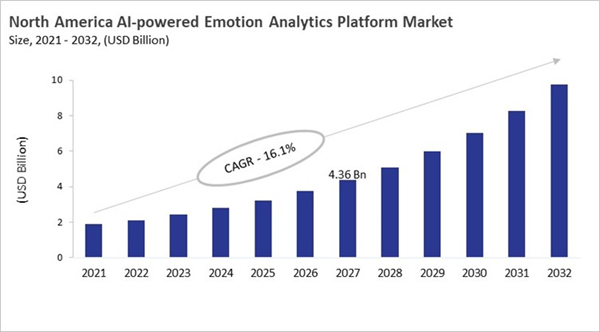The US market dominated the North America AI-powered Emotion Analytics Platform Market by country in 2024, and is expected to continue to be a dominant market till 2032; thereby, achieving a market value of $7.02 billion by 2032. The Canada market is experiencing a CAGR of 19.5% during 2025-2032. Additionally, the Mexico market is expected to exhibit a CAGR of 18.6% during 2025-2032. The US and Canada led the North America AI-powered Emotion Analytics Platform Market by Country with a market share of 75.9% and 11.9% in 2024.
The North American market for AI-powered emotion analytics platforms has grown quickly because advanced AI and machine learning technologies are being used in many business and consumer apps. The field started out with simple text-based sentiment analysis, but it has grown into complex multimodal systems that use facial recognition, speech analysis, and physiological monitoring. These tools have been adopted by industries like healthcare, retail, and marketing to make experiences more personal, keep an eye on mental health, and boost engagement. Government-funded AI research and ethical guidelines have helped new ideas grow while also protecting people's privacy. Cloud-based platforms have helped growth even more by giving businesses the ability to scale, access data from anywhere, and analyze data in real time. Facial recognition is now the most popular technology segment.
There is a lot of focus on ethical AI practices, following the rules, and protecting people's privacy, especially since platforms deal with sensitive emotional data. Some of the most important trends are the growth of multimodal emotion recognition for more detailed insights and the use of this technology in new areas like education, cars, and entertainment. Top companies are focusing on research and development, partnerships, and customization to stay ahead of the competition while also balancing new ideas with moral concerns. Big tech companies have the most infrastructure and reach, but startups bring flexibility and new ideas to specific areas. Cloud solutions are more popular because they are more flexible, but on-premises models are still useful for industries that need to keep their data safe. Facial recognition is the most profitable technology, followed by multimodal systems, voice analysis, natural language processing (NLP), and physiological monitoring. The last one is taking longer to catch on because it is hard to integrate.
End-User Outlook
Based on End-User, the market is segmented into Healthcare, Retail & E-commerce, Automotive & Transportation, Media & Entertainment, IT (tech firms, CX platforms, enterprise apps), Education, Government & Public Safety, BFSI, and Other End-Users. Among various US AI-powered Emotion Analytics Platform Market by End-User; The Healthcare market achieved a market size of USD $486.9 Million in 2024 and is expected to grow at a CAGR of 14 % during the forecast period. The Government & Public Safety market is predicted to experience a CAGR of 17.5% throughout the forecast period from (2025 - 2032).Technology Outlook
Based on Technology, the market is segmented into Facial Recognition, Multimodal Emotion Recognition, Speech & Voice Analysis, Text-based Emotion Detection (NLP), and Physiological Monitoring (wearables, biometrics). With a compound annual growth rate (CAGR) of 18.5% over the projection period, the Facial Recognition Market, dominate the Canada AI-powered Emotion Analytics Platform Market by Technology in 2024 and would be a prominent market until 2032. The Physiological Monitoring (wearables, biometrics) market is expected to witness a CAGR of 20.4% during 2025-2032.Country Outlook
Canada’s AI-powered emotion analytics platform market is steadily expanding, fueled by technological innovation, strong government support, and growing adoption across sectors like healthcare, education, and customer service. The integration of AI with multimodal emotion recognition - using facial cues, voice, and physiological data - is enhancing personalization, engagement, and human-computer interaction. Government initiatives such as CIFAR and the Pan-Canadian AI Strategy support research, ethical deployment, and privacy compliance. The market features a competitive mix of global tech firms and local startups, like Hume AI, driving innovation through academic-industry collaboration. Real-world applications range from emotionally intelligent voice assistants to telehealth platforms optimizing patient care, reflecting Canada's leadership in ethical and advanced AI adoption.List of Key Companies Profiled
- Runtime Collective Limited (Brandwatch)
- Sprout Social, Inc.
- IBM Corporation
- Apple, Inc.
- NEC Corporation
- OpenText Corporation
- iMotions A/S (Smart Eye A/S)
- Lexalytics, Inc.
- NVISO SA
- Emotibot Technologies Limited
- Microsoft Corporation
Market Report Segmentation
By Deployment
- Cloud
- On-premises
By Technology
- Facial Recognition
- Multimodal Emotion Recognition
- Speech & Voice Analysis
- Text-based Emotion Detection (NLP)
- Physiological Monitoring (wearables, biometrics)
By End User
- Healthcare
- Retail & E-commerce
- Automotive & Transportation
- Media & Entertainment
- IT (tech firms, CX platforms, enterprise apps)
- Education
- Government & Public Safety
- BFSI
- Other End-Users
By Country
- US
- Canada
- Mexico
- Rest of North America
Table of Contents
Companies Mentioned
- Runtime Collective Limited (Brandwatch)
- Sprout Social, Inc.
- IBM Corporation
- Apple, Inc.
- NEC Corporation
- OpenText Corporation
- iMotions A/S (Smart Eye A/S)
- Lexalytics, Inc.
- NVISO SA
- Emotibot Technologies Limited
- Microsoft Corporation










